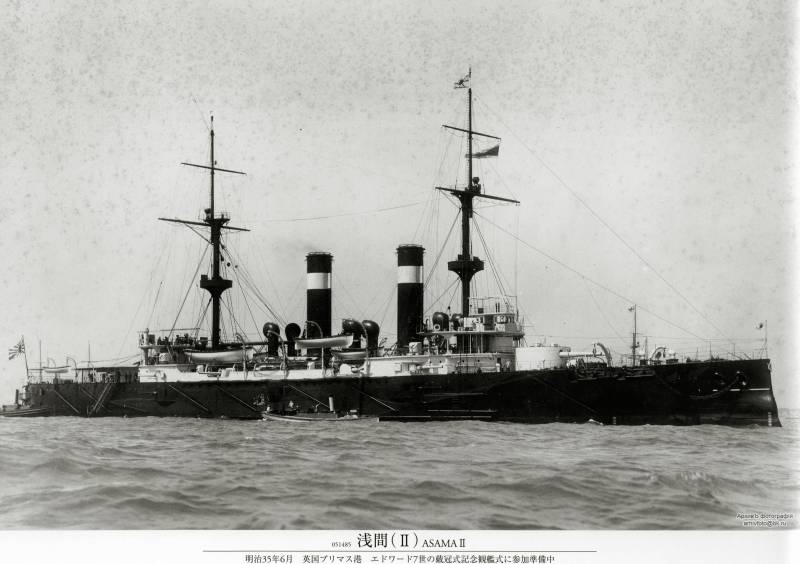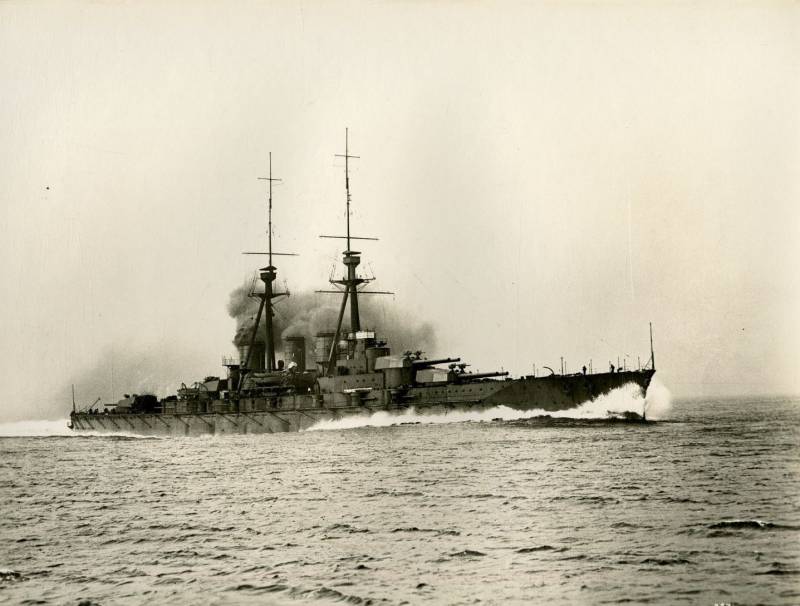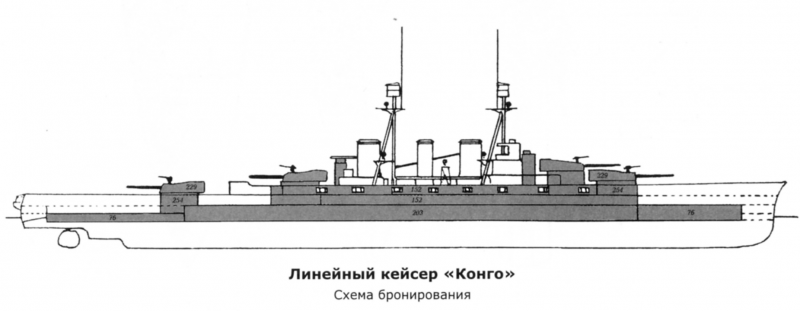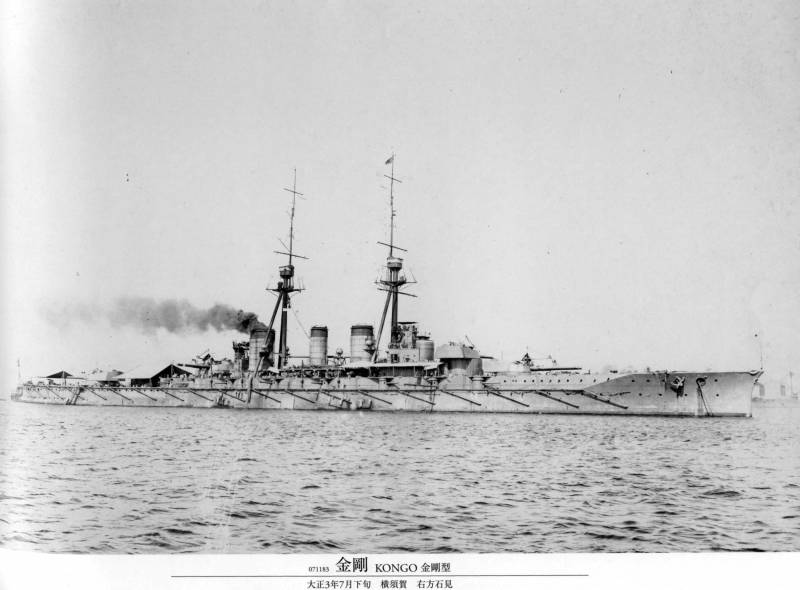Congo-class battlecruisers
History Japanese battlecruisers began in the Battle of Yalu, during which the fleet of cruisers played a significant, if not decisive, role. However, according to the analysis of this battle, the Japanese concluded that their small armored cruisers did not meet the tasks of a squadron battle with armadillos, and that they needed completely different ships for this. Without a doubt, the new cruisers were supposed to be high-speed, armed with high-speed artillery of 8 inches inclusive, but at the same time they should also be protected with armor capable of withstanding shells of the same caliber. As a result of this decision, the Japanese fleet received six very powerful armored cruisers, and then, on the eve of the war with Russia, was able to buy two more Italian ships, received in the United navy the names "Nissin" and "Kasuga".
As is known, the sea power of the Russian Empire in the 1904-1905 war. was crushed. The Japanese were very pleased with the actions of their armored cruisers, and all their subsequent shipbuilding programs required the presence of such ships as part of the fleet.
Frankly, this decision of the Japanese is, at least, controversial. After all, if you think about it, then what really made their armored cruisers? Without a doubt, the commanders of the Assam, under the protection of very good armor, would have been easy to shoot the Varyag armored cruiser, even if the Russian artillerymen could have driven several of their shells into the armored cruiser of the Japanese.
But “Varyag” in any case was doomed, regardless of whether Chelmulpo had “Assam” or not - the Japanese were superior in numbers. In the 27 battle of January, the armored cruisers of Japan showed themselves nothing. Four armored Japanese cruisers took part in the battle in the Yellow Sea, but how? "Nissin" and "Kasuga" were put in one column with the battleships, that is, the Japanese deliberately abandoned the benefits that gave them the use of armored cruisers as a high-speed wing. Instead, Nissin and Kassuga were forced to portray classical armadillos, but they were too poorly armored and armed for this role. And only bad shooting of the Russian commanders saved these cruisers from heavy damage.
As for the other two armored cruisers, they also did not earn any laurels - the “high-speed” “Asama” was never able to join the battleships of Togo and did not take part in the battle of the main forces, but the “Yakumo” did succeed, but only in the second half of the battle. Some serious achievements are not listed for him, and the only 305-mm Russian projectile that fell into it caused Yakumo significant damage, which confirmed the danger of using this type of cruiser in battle against full-fledged squadron battleships. In Tsushima, Nissin and Kassuga were again forced to pretend to be “battleships”, and the Kamimura squad, although it had a certain independence, also did not act as a “fast wing”, but acted simply as another squad of battleships. As for the battle in the Korean Strait, here the Japanese suffered a real fiasco - after a successful hit knocked out "Rurik" out of order, four armored cruisers Kamimura, having in front of him half the size of the enemy ("Gromoboy" and "Russia") , during the many hours of battle, they could neither destroy nor even destroy at least one of these ships, despite the fact that the Russian armored cruisers that opposed them were never intended to be used in a squadron battle.
No doubt, any Japanese armored cruiser cost significantly less than a full-bodied battleship in 15 000 tons, and it can be assumed that two battleships of the Asahi or Mikasa cost approximately as much as three armored cruisers. However, there is no doubt that if the Japanese had an armadillo instead of 4 armored cruisers at the beginning of the war, their fleet could have achieved greater success. In general, in the opinion of the author of this article, the armored cruisers of the United Fleet as a class of warships did not completely justify themselves, but the Japanese obviously had a different opinion on this issue.
Nevertheless, the Japanese admirals made some conclusions, namely, they understood the absolute insufficiency of the 203-mm guns for a squadron battle. All the battleships and armored cruisers of Togo and Kamimura were built abroad, and after the Russo-Japanese War, two more battleships built in England were included in the United Fleet: Kashima and Katori (both were laid out in 1904 g). However, Japan subsequently stopped this practice, and began construction of heavy warships in its own shipyards. And the very first Japanese armored cruisers of their own construction (of the “Tsukuba” type) received the 305-mm artillery systems - the same as the battleships. Both the Tsukuba type ships and the Ibuki and Kurama that followed were the main-caliber ships of the battleships, while a higher speed (21,5 knots against 18,25 knots) was achieved by weakening the average caliber (with 254-mm to 203 mm) and reservations (from 229 mm to 178 mm). Thus, the Japanese were the first in the world to realize the need to arm large cruisers with the same main caliber as the battleship, and their Tsukuba and Ibuki next to the Kasims and Satsuma looked very organic.
But then the British shook the world with their Invincibles and the Japanese thought about the answer - they wanted to have a ship that was in no way inferior to English. All in all, but in Japan they didn’t know the exact tactical and technical characteristics of Invincible, and therefore the design of an armored cruiser with a 18 displacement 650 t with 4 305-mm 8, 254 10-mm and 120 small caliber guns was created as well as 8 torpedo tubes. Reservations remained at the same level (5 mm of armor belt and 178 mm deck), but the speed had to make 50 nodes, for which the power plant power should be brought to 25 44 hp
The Japanese were already ready to lay the new armored cruiser, but at this time, finally, reliable data appeared on the main Invibible caliber. Admirals Mikado grabbed his head - the designed ship was clearly outdated before the launch, and the designers immediately set to work. The displacement of the armored cruiser increased by 100 t, the power of the power plant and the reservation remained the same, but the ship received ten 305-mm / 50 guns, the same six-inch gun, four 120-mm guns and five torpedo tubes. Apparently, the Japanese properly “conjured” over the ship's lines, because with the same power they now expected to get 25,5 nodes of maximum speed.
The Japanese made several projects of the new ship - in the first of them the artillery of the main caliber was located like the German Moltke, in the next five towers were placed in the center plane, two in the extremities and one in the middle of the hull. In 1909 g, the project of the first battlecruiser of Japan was completed and approved, all necessary drawings and specifications for the start of its construction were developed, and funds for construction were allocated by the budget. But at this very moment messages about laying the battle cruiser Lion came from England ... And the completely ready project became outdated again.
The Japanese realized that progress in the development of naval armaments was still too fast for them, and that, trying to replicate the designs of England, they were unable to create a modern ship — as long as they reproduce what the UK built (even with some improvements), British engineers create something completely new. Therefore, in developing the next project, the Japanese made extensive use of English help.
Vickers proposed to create a battle cruiser according to the improved design of the Lion, Armstrong - a completely new project, but after some hesitation the Japanese were inclined to the proposal of the Vickers. The contract was signed on 17 in October of 1912. At the same time, the Japanese, of course, were counting not only on design assistance, but on receiving the latest British technologies for the production of power plants, artillery and other ship equipment.
The battleship for the United Fleet was now created as an improved Lion, and its displacement quickly grew to 27 000 tons, and this, of course, excluded the possibility of building this ship in Japanese shipyards. As for the caliber of the guns, after long discussions about the benefits of increasing the caliber, the Japanese were still confident that the 305-mm / 50 guns would be the best choice for their ship. Then the British made a "drain" of information - the Japanese naval attache got completely secret comparative test data, during which it became clear that the 343-mm artillery systems, installed on the latest British battlecruisers, significantly outperform the 305-mm / 50 guns the English.
After reviewing the test results, the Japanese radically changed their approach to the main caliber of the future ship - now even the 343-mm guns did not suit them, and they wished for the 356-mm artillery system. Of course, to the great joy of the Vickers, who was tasked with developing a new 356-mm gun for the Japanese battle cruiser.
Artillery
I must say that the main caliber of the Congo-class battlecruisers is no less mysterious than the British 343-mm cannon. As we said earlier, the artillery of the Lion and Orion dreadnoughts received 567 kg shells, subsequent British ships with 13,5-inch guns received heavier 635 kg ammunition. As for the initial speed, there are no exact data - according to the author, the figures of VB are the most realistic. Muzhzhenikov, giving 788 and 760 m / s for "light" and "heavy" shells, respectively.
But what is known about the 356-mm / 45 gun of the Japanese fleet? Obviously, it was created on the basis of the British artillery system, while its construction (wire) repeated the design of heavy British guns. But practically nothing is known about the shells for them: we only know that the British, without any doubt, delivered a number of armor-piercing and high-explosive 356-mm shells to Japan, but later the Japanese mastered their production at domestic enterprises.
Some clarity exists only with post-war ammunition - the Japanese Type 91 armor-piercing projectile had a mass of 673,5 kg and an initial velocity of 770-775 m / s. High explosive is more difficult - it is assumed that Type 0 had 625 kg at the initial speed of 805 m / s., But in some publications it is indicated that its weight was higher and amounted to 652 kg. However, I would like to note that on the background of 673,5 kg and 775 m / s armor-piercing projectile, 625 kg and 805 m / s high-explosive look quite organic, but 852 kg and 805 m / s - no, which makes us suspect a banal typo ( instead of 625 kg - 652 kg).
Thus, we can assume that initially 356-mm / 45 guns of Congo-type battlecruisers received an equal-weight 343-mm British 635 kg projectile, which the gun sent to the flight at an initial speed of approximately 790-800 m / s or about that. By the way, these characteristics very well "echo" and with the American 356-mm / 45 guns mounted on the battleships of the types "New York", "Nevada" and "Pennsylvania" - they shot 635 kg with a projectile with an initial speed of 792 m / s. Unfortunately, there are no data on the filling of explosives with shells supplied by England, but it can be assumed that the explosive content did not exceed that of similar British 343-mm shells, i.e. 20,2 kg for armor-piercing and 80,1 kg for high-explosive, but these are only guesses.
Without a doubt, the Japanese got an excellent weapon, which in its ballistic qualities was not inferior to the American one, at the same time slightly superior to the British 343 guns, and besides, it had a great resource - if the British guns were designed for 200 shots of 635 kg shells, the Japanese - on 250-280 shots. Perhaps the only thing that they can be reproached for is the British armor-piercing shells, which turned out to be very poor-quality (as shown by the Battle of Jutland), but subsequently the Japanese eliminated this shortcoming.
I must say that the Japanese ordered the British 356-mm guns "Congo" even before they learned about the transition of the US Navy to 14-inch caliber. Therefore, the news about the 356-mm caliber on the "New York" was perceived by the Japanese admirals with satisfaction - they finally managed to correctly predict the direction of development of heavy artillery ships, the United Fleet did not become an outsider.
In addition to the superiority of the artillery systems themselves, the Congo gained an advantage in the placement of artillery. As is known, the third tower of the Lion-type battlecruisers was located between the boiler rooms, that is, between the chimneys, which limited the firing angles. At the same time, the third Congo tower was placed between the engine and boiler rooms, which made it possible to place all three pipes of the battlecruiser in the space between the second and third towers, which made the ship’s retractable fire in no way inferior. At the same time, the separation of the third and fourth towers did not allow them both to be removed with a single hit, which the Germans were afraid of and how it actually happened to Zeidlitz in the battle of Dogger Banks. Probably, the location of the tower between the engine rooms and boiler rooms had its drawbacks (and at least the need to pull steam lines near the artillery cellars), but the situation on the Lion was the same, so in general, of course, the location of the main caliber Congo ”was noticeably more progressive than that adopted on British battlecruisers. The 356-mm guns for the Japanese fleet apparently also surpassed British ships - confusion is possible here, since the towers of Congo-type battlecruisers were repeatedly upgraded, but presumably their maximum angle of vertical guidance reached 25 when built.
As for the medium artillery "Congo", then there are some oddities. There are no mysteries in the artillery systems themselves - the first liner cruiser of Japan received the 16 152-mm / 50 guns, which were developed by the same Vickers. These guns were quite at the level of the world's best counterparts, sending projectiles with an initial speed of 45,36-850 m / s in flight of 855.
Sources usually indicate that the Japanese did not approve of Fisher’s ideas about the minimum anti-mine caliber, because they knew very well from the experience of the Russo-Japanese War that to defeat attacking destroyers reliably, heavier guns were needed than the 76-102 mm artillery systems installed on British battleships and battle cruisers. But this, seemingly quite logical point of view, categorically does not fit the presence of the second anti-mine caliber on the battle cruisers of Japan - sixteen 76-mm / 40 installations, partly located on the roofs of the main-caliber towers, and in the middle of the ship. All this makes it possible to suspect the Japanese in a purely German approach, because in Germany they have not seen a single reason why the concept of “only big guns” should exclude the presence of medium caliber. As a result, the German dreadnoughts and battlecruisers were armed with both medium (15-cm) and anti-mine (8,8-cm) caliber, and we see something similar on Congo-class battlecruisers.
The torpedo armament of the Japanese ships was also reinforced - instead of two 533-mm torpedo tubes, the Lion and Congo received eight.
Reservation
Unfortunately, the information on the original booking of Congo-class battlecruisers is very contradictory. Perhaps the only element of the ship’s defense, according to which the sources came to a common opinion, is its main armor belt. The Japanese absolutely did not like the British “mosaic” protection system, in which the engine and boiler rooms of the Lion-type battlecruisers defended 229-mm, but the areas of the artillery cellars of the bow and stern towers were only 102-152-mm armor. Therefore, the Japanese went a different way - they reduced the thickness of the citadel to 203 mm, but it defended the board, including the areas of the towers of the main caliber. More precisely, the armor belt did not reach the fourth tower facing the barbet, but the oblique (from the edge of the armor belt through the body to the barbet) of traverses 152-203 mm thick went from it. In the nose of the citadel closed traverse the same thickness, but located perpendicular to the board.
So, conceding 229 mm to the protection of Lion in thickness, the main armor of the Congo had a greater length, as well as a height that was 3,8 m against 3,5 m of Lion. Under normal displacement, the 203-mm Congo armored plates submerged about half in the water, which also distinguished the protection of the Japanese ship from its English “predecessors” (the 229-mm Lion armor was deepened by 0,91 meters). At the same time, below the 203 mm of the armor belt along the entire length from the bow to the aft towers, inclusive, the underwater part of the hull was also protected by a narrow (65 cm of height) 76 mm band of armor.
Outside the citadel, the board defended 76 mm armor, which had the same height in the nose as the 203-mm armor, but in the stern 76-m armor was significantly less. The extremities of the Congo were armored for almost the entire length, the defense did not reach the stem and stern-steed only a little. Above the main armored belt, the board defended 152 mm with armor up to the upper deck, including the casemates of the 152-mm guns located in the ship's hull.
Horizontal protection "Congo" is the subject of numerous disputes, and, alas, reliably about it, nothing is known. O.A. Rubanov, in his monograph devoted to Congo-class battlecruisers, writes:
I would like to immediately note a typo - 2,75 inches are approximately 69,9 mm, but it is extremely doubtful that the armor has a similar or similar thickness. You just need to remember that the "Lion" had several decks, some of which (main deck, deck of the forecastle) had an increased thickness. For example, the thickness of the armor deck “Lion” both in the horizontal part and on the bevels was 25,4 mm (that is, one inch), but the upper deck within the citadel was also thickened to 25,4 mm, so theoretically there is reason to declare About 50 mm Vertical Protection "Lion". And for a small part of the deck the forecastle in the area of chimneys had 38 mm of thickness - and this again can be “counted” in addition to the previously calculated 50 mm. But even without resorting to this kind of juggling, it is easy to remember that in the bow and stern, outside the citadel, Lion’s armored decks reached 64,5 mm of thickness.
In other words, we see that the booking of “Lion” is completely impossible to characterize by naming one of some kind of thickness, because it will not be clear what is included there. It is quite possible, for example, that the Congo armored deck actually reached 70 mm - outside the citadel, where the Lion had 64,5 mm armor, but what does this tell us about the horizontal defense of the Congo as a whole? Nothing.
Nevertheless, the author is inclined to believe that within the limits of the Congo citadel 50 mm was protected by armor, since this thickness is quite consistent with the protection that the Japanese provided for in the preliminary projects of the battle cruisers. In addition, the United Fleet assumed that its future battles would take place at great distances and it would be reasonable if its requirements for horizontal booking were greater than those of the British. At the same time, the 50 mm Armored Deck does not look excessively heavy for the Congo-class battle cruiser. But, of course, one cannot exclude the possibility that the battlecruiser, like its English "colleagues", had an 25 mm armored deck and a 25 mm upper deck.
About the defense of the towers, alas, there is also no complete data, it is indicated that the towers and barbettes defended 229 mm armor (although a number of sources indicate 254-mm), but it is obvious that barbety could have such protection only above the upper deck - lower, opposite the sides first protected 152 mm, and then, perhaps, 203 mm armor (unfortunately, it is completely unknown at what height from the waterline there was an armor-deck) barbety, obviously, would have to have a smaller thickness.
About the conning tower, unfortunately, the author of this article does not know anything, we can only assume that its maximum thickness, by analogy with the "Lion", did not exceed 254 mm.
Power plant
The power rating of the Congo machines, consisting of Parsons 4 turbines and Yarrow 36 boilers, was 64 000 hp, which was even slightly less than Lyon’s 70 000 hp. At the same time, the Congo was heavier, its normal displacement was 27 500 t against 26 350 t of the British battle cruiser, but still the chief designer D. Thurston believed that the Japanese ship would reach 27,5 knots, that is, half a node above the contract speed “ Lion. The maximum fuel supply reached 4 200 tons of coal and 1 000 tons of fuel oil, with this reserve the Congo's range should have been 8 000 miles at a speed of 14 knots.
In general, it can be stated that the Congo has become a battlecruiser in the traditional British style - little armor and a lot of speed with the biggest guns. But with all this, he was superior to the ships of the type "Lion" and "Queen Mary" - his artillery was more powerful, and the defense - more rational. Accordingly, a funny situation has developed - in the British shipyards for the Asian state a more perfect ship is being built than for His Majesty’s fleet. Of course, this was unacceptable, and the fourth UK cruiser carrying the 343-mm guns, which was originally supposed to be built with a copy of Queen Mary, was created using a new, improved project.
Продолжение следует ...




Information